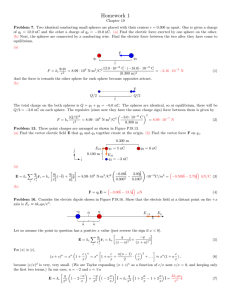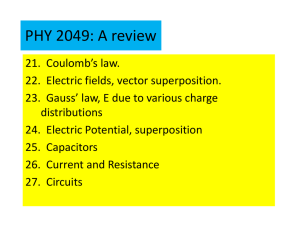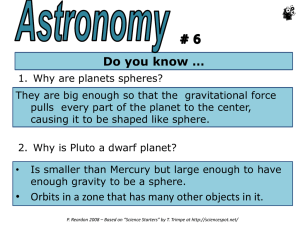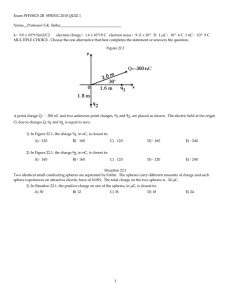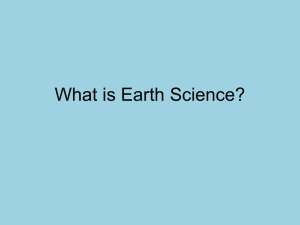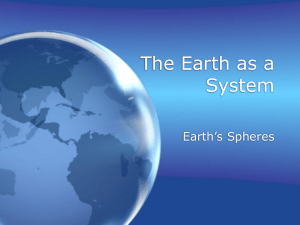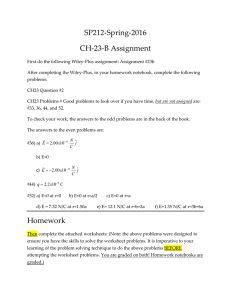Two Conducting Spheres at the Same Potential - Physics
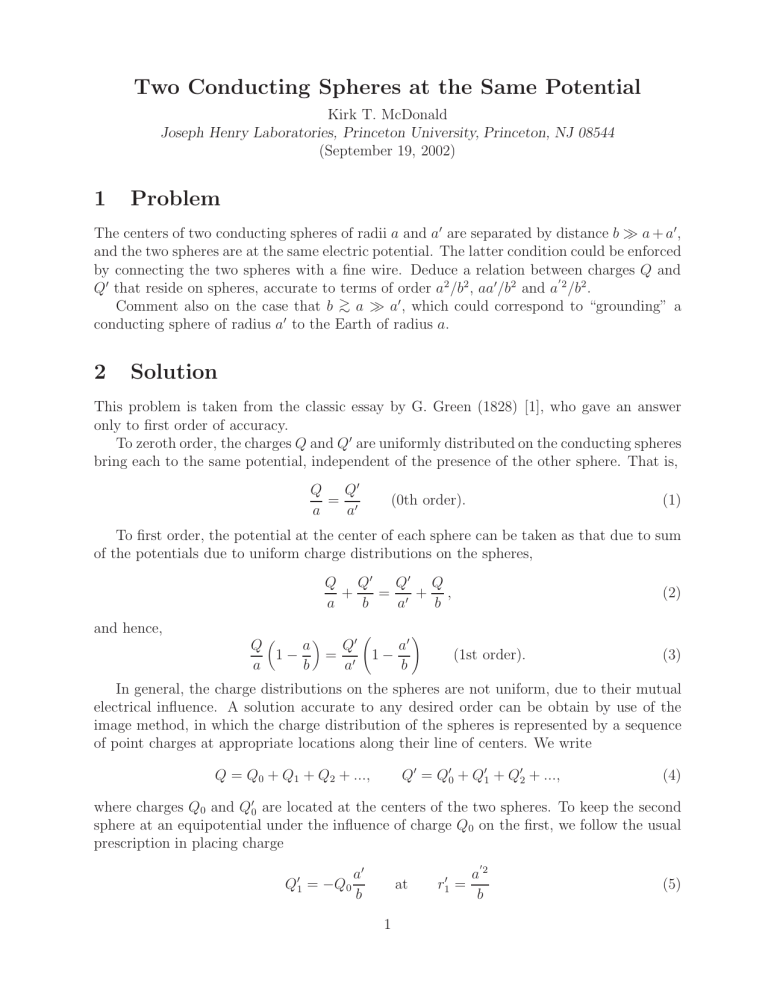
Two Conducting Spheres at the Same Potential
Kirk T. McDonald
Joseph Henry Laboratories, Princeton University, Princeton, NJ 08544
(September 19, 2002)
1 Problem
The centers of two conducting spheres of radii a and a are separated by distance b a + a and the two spheres are at the same electric potential. The latter condition could be enforced
, by connecting the two spheres with a fine wire. Deduce a relation between charges Q and
Q that reside on spheres, accurate to terms of order a
Comment also on the case that conducting sphere of radius a b > a a to the Earth of radius a .
2
/b
2
, aa /b
2 and a
2
/b
2
.
, which could correspond to “grounding” a
2 Solution
This problem is taken from the classic essay by G. Green (1828) [1], who gave an answer only to first order of accuracy.
To zeroth order, the charges Q and Q are uniformly distributed on the conducting spheres bring each to the same potential, independent of the presence of the other sphere. That is,
Q a
=
Q a
(0th order) .
(1)
To first order, the potential at the center of each sphere can be taken as that due to sum of the potentials due to uniform charge distributions on the spheres,
Q a
+
Q b
=
Q a
+
Q b
, (2) and hence,
Q a
1
− a b
=
Q a
1
− a b
(1st order) .
(3)
In general, the charge distributions on the spheres are not uniform, due to their mutual electrical influence. A solution accurate to any desired order can be obtain by use of the image method, in which the charge distribution of the spheres is represented by a sequence of point charges at appropriate locations along their line of centers. We write
Q = Q
0
+ Q
1
+ Q
2
+ ..., Q = Q
0
+ Q
1
+ Q
2
+ ..., (4) where charges Q
0 and Q
0 are located at the centers of the two spheres. To keep the second sphere at an equipotential under the influence of charge Q 0 on the first, we follow the usual prescription in placing charge
Q
1
=
−
Q 0 a b at r
1
= a
2 b
(5)
1
from the center of the second sphere. Likewise, to keep the first sphere at an equipotential, we place charge
Q 1 =
−
Q
0 a b a
2 at r 1 = b
(6) from the center of that sphere. Then, to keep the spheres at equipotentials under the influence of charges Q
1 and Q
1
, we add charges
Q
2
=
− Q
1 a b
− r 1
= Q
0 b
2 aa
− a
2 at r
2
= a
2 b
− r 1
, (7) and
Q 2 =
−
Q
1 a b
− r
1
= Q 0 b
2 aa
− a
2 at r 2 = a
2 b
− r
1
, (8) etc.
The additional charges Q
1
, Q
2
, ..., Q
1
, Q
2
, ..., have been positioned so that they do not change the potentials of the two spheres. The condition that the two spheres be at the same potential is therefore
Q a
0
=
Q a
0
.
To 2nd order, the total charge on the first sphere can now be written as
(9)
Q = Q
0
+ Q
1
+ Q
2
= Q
0
−
Q
0 a b
+ Q
0 b
2 aa
− a
2
= Q
0
1
− a b
+ b
2 aa
− a
2
, (10) while
Q = Q
0
+ Q
1
+ Q
2
= Q
0
−
Q
0 a b
+ Q
0 b
2 aa
− a
2
= Q
0
1
− a b
+ b
2 aa
− a
2
We eliminate Q
0 and Q
0 by using eq. (9) again to find (for any b > a + a )
Q a
1
− a
+ b b
2 aa
− a
2
=
Q a
1
− a b
+ b
2 aa
− a
2
.
.
(11)
(12)
The result (12) was first obtained by Thomson [2]. See also sec. 174 of [3], from which the expansion to fifth order can be inferred. At third order, eq. (12) becomes
Q a
1
− a b
+ b
2 aa
− a
2
− b ( b
2 a
2 a
− a
2 − a
2
)
=
Q a
1
− a b
+ b
2 aa
− a
2
− b ( b
2 aa
2
− a
2 − a
2
)
.
(13)
To 2nd order of accuracy when b a + a this can also be written as
Q a
1
− a b
+ aa b
2
=
Q a
1
− a b
+ aa b
2
.
(14)
The 1st-order result (3) is contained within the 2nd-order result (14), as expected.
2
2.1
“Grounding:”
b = a + d
with
a d a
This section added Sept. 5, 2011.
When a d a , the electric field due to the large sphere in the vicinity of the small sphere (and in its absence) is essentially uniform with value E a = Q/a
2
. The potential due to charge Q at distance d above the surface of the large sphere is lower that the surface potential Q/a by Δ V
≈
E a d = Qd/a . When the small sphere is at distance d , placing charge Q on it raises its potential by Q /a , so with charge
Q
≈ a d a
2
Q, (15) the small sphere has the same potential as the large one.
Surprisingly, this result does not follow from the second-order image result eq. (12), in that the terms in parenthesis on the left can be approximated as d/a + a / 2 d and the terms in parenthesis on the right by 1, to find
Q ≈ a a d a
+ a
2 d
Q (second order) .
(16)
However, when we use the third-order result (13) the (relatively large) term a / 2 d in eq. (16) is cancelled and we obtain eq. (15).
For example, if the first sphere is the Earth with raidus a
≈
6 .
4
×
10
8 sphere has radius a = 1 cm at distance d cm and the small
= 10 m above the Earth, then “grounding” the small sphere to Earth via a fine wire would leave it with charge
Q ≈ a a
2 d
Q ≈ −
1
·
10
3 ·
5
×
4
×
10
17
10
5
≈ −
10
− 9
C , (17) noting that the electric charge Q of the Earth is about
−
500 , 000 C [4].
“Grounding” a conductor does not reduce its charge to zero, but only to a practically negligible amount.
2.2
Two Conducting Spheres in Contact
A solution by the method of inversion is given in sec. 175 of [3] and by the method of images in [5]. For a a the charges on the two conducting spheres, in contact, are related by
Q ≈
π
2 a
2
6 a
2
Q = 1 .
65 a
2 a
2
Q, which is slightly larger than the prediction of eq. (15) when d = a .
(18)
References
[1] G. Green, Mathematical Papers , (Chelsea Publishing Co., Bronx, NY, 1970), pp. 55-56, http://puhep1.princeton.edu/~mcdonald/examples/EM/green_papers.pdf
3
[2] W. Thomson, On the Mutual Attraction or Repulsion between two Electrified Spherical
Conductors , Phil. Mag.
5 , 287 (1853), http://puhep1.princeton.edu/~mcdonald/examples/EM/thomson_pm_5_287_53.pdf
[3] J.C. Maxwell, A Treatise on Electricity and Magnetism , 3rd ed. (Clarendon Press, 1904), http://puhep1.princeton.edu/~mcdonald/examples/EM/maxwell_treatise_chap11_images.pdf
[4] M.A. Uman, The Earth and Its Atmosphere as a Leaky Spherical Capacitor , Am. J.
Phys.
42 , 1033 (1974), http://puhep1.princeton.edu/~mcdonald/examples/EM/uman_ajp_42_1033_74.pdf
[5] G. Tong, Charge distributions of two conducting spheres , Euro. J. Phys.
13 , 186 (1992), http://puhep1.princeton.edu/~mcdonald/examples/EM/tong_ejp_13_186_92.pdf
4
